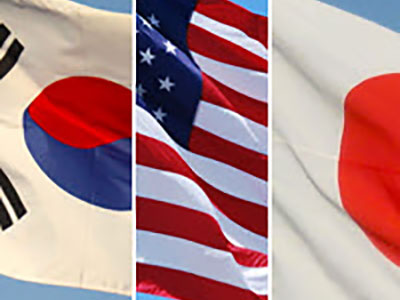Next Steps toward Allied Energy Security
Jeremy Maxie (Strategika Group Asia Pacific) and Tatsuo Masuda (Nagoya University of Commerce and Business; FairCourt Capital) highlight important initiatives of economic statecraft among the United States, Japan, and South Korea that have the potential to reshape energy security and geoeconomics in the Indo-Pacific region.
President Donald Trump’s twelve-day visit to Asia in November resulted in the launch of several important initiatives of economic statecraft with Japan and South Korea. Although they were overshadowed by calls for trade reciprocity and North Korea’s nuclear brinkmanship, these initiatives have the potential to reshape energy security and geoeconomics in the so-called Indo-Pacific region.
Specifically, Washington and Tokyo launched the Japan–United States Strategic Energy Partnership (JUSEP), while Seoul and Washington established a Partnership in Energy Security. These energy security initiatives were accompanied by agreements between the U.S. Trade and Development Agency and Japan’s Ministry of Economy, Trade and Industry (METI), as well as between the U.S. Overseas Private Investment Corporation and Japanese partners, aimed at promoting high-quality infrastructure in the Indo-Pacific. [1]
These developments are an important first step toward the networked “allied energy security” strategy that we advocated in a recent working paper for the National Bureau of Asian Research. [2] We are particularly encouraged that the JUSEP, as outlined by METI, closely tracks with our policy recommendations for a trilateral energy security partnership that draws on the abundance of U.S. oil and gas production to strengthen Japan’s and South Korea’s energy security as well as revolutionize the market for liquefied natural gas (LNG) in Asia. [3]
Energy Security Trends
Japan and South Korea have a dangerously high dependence (over 80% for oil) on Middle East energy imports that expose these two U.S. allies to the dual risks of upstream and maritime supply disruptions. [4] This double jeopardy is a significant alliance risk. Increasing instability and shifting geopolitical alignments in the Middle East add urgency and uncertainty to the need for both countries to reduce and diversify these dual import dependencies.
The unprecedented growth in shale oil and gas production—which will likely make the United States the world’s largest LNG exporter as well as a net oil exporter by the mid-2020s—is a potential game changer for Asian energy security for several reasons. [5] This surge in U.S. oil and LNG exports has the potential to strengthen Japan’s and South Korea’s energy security by increasing the diversity of supply sources and routes. Although the market will largely determine how much U.S. oil and LNG is exported to Asia, the United States is strongly positioned to step into the role of “supplier of last resort” in the event of a supply disruption or a demand shock. Equally important to Asian energy security, if not more so, U.S. LNG exports are not encumbered by destination restrictions or linked to oil-indexed pricing, making them indispensable in establishing an LNG trading hub in Asia.
Furthermore, linking energy security cooperation to the development of high-quality infrastructure in third countries will deepen and broaden the regional LNG market and promote the use of natural gas in power generation. Such an approach complements Japan’s Expanded Partnership for Quality Infrastructure as well as the ambitious Asia-Africa Growth Corridor that Japan launched bilaterally with India. [6] Together, these partnerships will play critical roles in helping preserve and expand “free and open” energy markets within the broader strategic context of a “free and open Indo-Pacific.”
This line of effort will provide the region with alternatives to China’s Belt and Road Initiative in cases where China’s offerings are not necessarily tailored to meet local needs or closely aligned with host government priorities. Focusing on high-quality infrastructure—rather than pushing a large quantity of quickly built and substandard projects with limited regard for environmental, social, and human rights impacts—will allow U.S., Japanese, and South Korean companies to leverage their comparative advantages.
Challenges
Despite these encouraging developments, several challenges remain in realizing the full potential of such cooperation. The first is to ensure that these energy and infrastructure initiatives become more than just a short-term boost for the private sector, whose interests are not always aligned, and may at times even conflict, with national interests. Washington, Tokyo, and Seoul will need to exercise oversight (and foresight) to ensure that any projects are aligned with their respective national interests as well as shared strategic objectives.
Second, Washington needs to work earnestly with Tokyo and Seoul at the commercial and diplomatic levels to bridge the gap between its separate bilateral initiatives with each ally until such time that formal trilateral arrangements can be realized. In the meantime, U.S., Japanese, and South Korean companies should form various consortia targeting oil and gas development in the United States, as well as high-quality energy infrastructure projects in Southeast Asia, South Asia, and Africa with coordinated backing in Washington, Tokyo, and Seoul.
Third, these bilateral initiatives should be networked to include other U.S. treaty allies (such as Thailand and the Philippines) as well as emerging partners (such as Indonesia and Vietnam). Southeast Asia, in particular, offers significant opportunities as the region shifts from being a net exporter to a net importer of LNG, while also pursuing an ambitious infrastructure build-out. Japan has already seized the initiative and demonstrated leadership in this regard. In October, it announced a public-private initiative to provide $10 billion in financial support to build LNG and natural gas infrastructure in Asia. [7] And while South Korea’s strategic focus is on Northeast Asia, President Moon Jae-in’s recent trip to Southeast Asia and rollout of the New Southern Policy suggest that the Blue House may be inclined to work with the United States and Japan in accelerating Southeast Asia’s shift to gas-fired power generation. [8]
More to the point, the greater long-term challenge will be maintaining policy continuity beyond the Trump, Abe, and Moon administrations. This will require cultivating support among key stakeholders, vertically and horizontally at the government and industry levels, with regard to the strategic value of a trilateral energy security partnership. Indeed, linking a scalable and networked strategy to coordinated efforts to promote high-quality infrastructure is consistent with the broader strategic agenda of ensuring a free and open Indo-Pacific.
Most importantly, in the pursuit of energy security and economic development, we must avoid a zero-sum race to the bottom in terms of rules, norms, and institutions that threaten to erode the foundations of democratic capitalism in favor of authoritarian state capitalism or spheres of influence. Working together to maintain and strengthen a free and open Indo-Pacific may seem a monumental task, given the complex challenges of the 21st century, yet it is not without precedent. Today’s leaders should take inspiration from the post–World War II generation whose idealism, global orientation, and strategic foresight laid the foundation for the rules-based international liberal order, which, although imperfect and evolving, has been remarkably successful. East Asia—notably war-stricken Japan—and Southeast Asia have benefited more than any other regions from this order.
However, these equities are not self-sustaining but require continual reinvestment in resources and commitment from primary stakeholders and beneficiaries. Furthermore, this system must also be backed up by a credible military deterrent and security architecture—primarily the U.S. hub-and-spoke security alliance. It is therefore imperative that policymakers resist the temptation to retreat into the false security of unilateralism, offshore-balancing, and economic protectionism in response to the global backlash against the excesses of what has been termed “hyperglobalization.” [9] Rather, realism requires that stakeholders step forward both to honor long-standing commitments by reinvigorating the rules-based liberal international order and to extend its benefits into the 21st century and across the Indo-Pacific. This also means strengthening and continuously improving the order’s underlying rules, norms, and institutions to become more equitable, sustainable, and inclusive.
It is in this larger strategic and historical context that a networked allied energy security and high-quality infrastructure partnership takes on greater meaning and purpose. A free and open energy market is one of the sinews of a free and open Indo-Pacific.
Endnotes
[1] Ministry of Economy, Trade and Industry (METI) (Japan), “Japan and the United States Affirm Advancement of Cooperation in the Fields of Energy and Infrastructure,” November 7, 2017, http://www.meti.go.jp/english/press/2017/1107_001.html.
[2] Jeremy Maxie and Tatsuo Masuda, “Allied Energy Security: The Role of U.S. Oil and LNG Exports in U.S. Relations with Japan and South Korea,” National Bureau of Asian Research, Working Paper, June 19, 2017, https://www.nbr.org/publication/allied-energy-security-the-role-of-u-s-oil-and-lng-exports-in-u-s-relations-with-japan-and-south-korea/.
[3] METI (Japan), “Japan–United States Strategic Energy Partnership (JUSEP),” Press Release, http://www.meti.go.jp/english/press/2017/pdf/1107_001a.pdf.
[4] For data on Japan, see U.S. Energy Information Agency (EIA), “Country Analysis Brief: Japan,” February 2, 2017, https://www.eia.gov/beta/international/analysis.cfm?iso=JPN. For data on South Korea, see EIA, “Country Analysis Brief: South Korea,” January 19, 2017, https://www.eia.gov/beta/international/analysis.cfm?iso=KOR.
[5] International Energy Agency, World Energy Outlook 2017 (Paris: OECD Publishing, 2017), https://www.iea.org/weo2017/#section-1-6.
[6] METI (Japan), “Expanded Partnership for Quality Infrastructure Initiative Directed toward the G7 Ise-Shima Summit Meeting Announced,” May 23, 2016, http://www.meti.go.jp/english/press/2016/0523_01.html; and “Asia Africa Growth Corridor: Partnership for Sustainable and Innovative Development: A Vision Document,” African Development Bank Meeting, May 2017, http://www.eria.org/Asia-Africa-Growth-Corridor-Document.pdf.
[7] “Japan Floats $10bn Plan to Build Out Asian LNG Market,” Nikkei Asian Review, October 19, 2017, https://asia.nikkei.com/Politics-Economy/Policy-Politics/Japan-floats-10bn-plan-to-build-out-Asian-LNG-market.
[8] Chang May Choon, “South Korean President Moon Jae In to Unveil Policy to Boost Ties with Asean,” Straits Times, November 6, 2017, http://www.straitstimes.com/asia/east-asia/south-korea-president-moon-jae-in-to-unveil-policy-to-boost-ties-with-asean.
[9] Dani Rodrik, “Populism and the Economics of Globalization,” John F. Kennedy School of Government, Harvard University, August 2017, https://drodrik.scholar.harvard.edu/files/dani-rodrik/files/populism_and_the_economics_of_globalization.pdf.
Jeremy Maxie is an Associate at Strategika Group Asia Pacific.
Tatsuo Masuda is Visiting Professor at the Nagoya University of Commerce and Business Graduate School and Chairman of FairCourt Capital in London.



